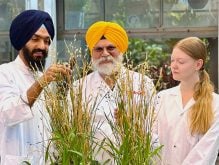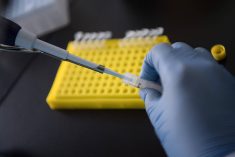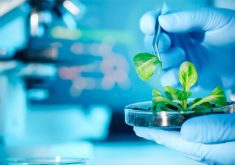Study indicates that the role of background mutations demands greater reassessment when developing new varieties
For about 80,000 years, evolution has shaped cherry-sized tomatoes that first originated in Ecuador. Farming and crop breeding led to bigger, sweeter varieties as they spread in popularity and diversity of uses.
Now, CRISPR gene editing can create new mutations with even greater improvements on desired traits. But none of these mutations, whether natural or engineered, work alone. There are thousands of those ancestral background mutations that can still influence outcomes.
But what if just one mutation could change a genome edited trait of a tomato? And that raised the question among scientists at Cold Spring Harbor Laboratory in New York as to how predictable plant breeding is.
Read Also

New coal mine proposal met with old concerns
A smaller version of the previously rejected Grassy Mountain coal mine project in Crowsnest Pass is back on the table, and the Livingstone Landowners Group continues to voice concerns about the environmental risks.
“This is a really fundamental question in genetics, and it is incredibly exciting that genetic engineering has gotten to a place where we can begin to answer it,” said David McCandlish, associate professor in the laboratory’s Simons Center for Quantitative Biology.
“The observation that the effect of a mutation may depend on the genetic background so that the same mutation might have different effects in different lineages goes back to the earliest days of genetics. The advance here (in this research) is to take a more systematic approach to understanding this background dependence.”
McCandlish and his colleague Zachary Lippman, Jacob Goldfield professor of genetics at CSHL, wondered if different natural and engineered mutations could have similar effects on tomato size, depending on the presence of two other gene mutations.
They used CRISPR gene editing to create a series of mutations in a gene known as SlCLV3. A natural mutation of this gene can increase fruit size.
“The key idea is that we can use CRISPR to make many different mutations in the same region of the genome and that, by making enough different mutations, we can get mutations across the full range of effect sizes from subtle to extreme,” said McCandlish. “In this case, we made mutations in a region of the genome that controls the expression of the gene SlCLV3. We then checked how the effects of these mutations changed when we combined them with other mutations known to interact with SlCLV3.”
This phenomenon in genetics is called epistasis, in which the effect on one particular genetic mutation is dependent on the presence of one or more other genes that provide the genetic background in which the particular mutation appears.
The report stated they collected more than 30,000 phenotypic data points from 46 tomato strains with different combinations of mutations. Researchers found that the SlCLV3 mutations produced more predictable effects when certain other mutations were also present. Mutations in one gene produced predictable changes in tomato size while mutations in another resulted in random outcomes.
The most valuable effect involved two mutations that first appeared millennia ago and were central in tomato domestication.
“In our study, we observed additional unpredictability in plants carrying three mutations beyond what we saw in the plants carrying only two mutations,” he said. “The idea that mutations that were behaving in a predictable way when combined as pairs but may not behave predictably when more mutations are combined definitely presents challenges for rational approaches to crop breeding.
“How best to deal with this unpredictability is an open question. It could be that the key is to search for genes where mutations have a predictable effect regardless of what background they occur in. On the other hand, it could be that the greatest gains come from taking advantage of these unpredictable interactions, and we argue that this is in fact what occurred during tomato domestication.”
While the latest research provides a better understanding of genetic predictability, context could be a key determining factor.
“Is genome editing a way to quickly bring in consumer benefits (such as) better flavour or nutrition?” said Lippman in the media release. “The answer is probably ‘yes’. The question is how predictable is it going to be?”
Research is continuing. In this stage of the study, the researchers made a collection of mutations in one gene and tested how individual mutations at other genes changed their effects.
McCandlish said a challenge now is to scale up the research to obtain large collections of mutations in several genes.
“Another important question is whether the pattern in the predictability of mutations we observe for these genes is the same or different in other Solanum species.”
Solanum is a genus of flowering plants that includes three food crops of high economic importance — potato, tomato and eggplant.
“One of the take-aways from our study is that the unpredictability induced by background mutations might be quite fine-grained,” said McCandlish. “We found that for the same set of focal mutations, one background mutation induced a lot of unpredictability, whereas the interactions with the other were smooth and highly predictable. While, here, we used genes that were important during tomato domestication as a model system, we think that we would see similar effects for other crop species and other traits.”
The research was recently published in the journal Science.

















